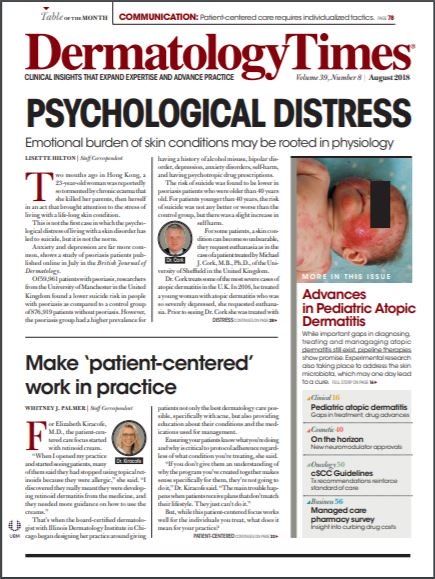- Acne
- Actinic Keratosis
- Aesthetics
- Alopecia
- Atopic Dermatitis
- Buy-and-Bill
- COVID-19
- Case-Based Roundtable
- Chronic Hand Eczema
- Chronic Spontaneous Urticaria
- Drug Watch
- Eczema
- General Dermatology
- Hidradenitis Suppurativa
- Melasma
- NP and PA
- Pediatric Dermatology
- Pigmentary Disorders
- Practice Management
- Precision Medicine and Biologics
- Prurigo Nodularis
- Psoriasis
- Psoriatic Arthritis
- Rare Disease
- Rosacea
- Skin Cancer
- Vitiligo
- Wound Care
Publication
Article
Dermatology Times
Make patient-centered work in practice
Author(s):
While patient-centered medicine works well for patients, what does it mean for the practice?
For Elizabeth Kiracofe, M.D., the patient-centered care focus started with retinoid cream.
“When I opened my practice and started seeing patients, many of them said they had stopped using topical retinoids because they were allergic,” she said. “I discovered they really meant they were developing retinoid dermatitis from the medicine, and they needed more guidance on how to use the creams.”
That’s when the board-certified dermatologist with Illinois Dermatology Institute in Chicago began designing her practice around giving patients not only the best dermatology care possible, specifically with acne, but also providing education about their conditions and the medications used for management.
Ensuring your patients know what you’re doing and why is critical to protocol adherence regardless of what condition you’re treating, she said.
“If you don’t give them an understanding of why the program you’ve created together makes sense specifically for them, they’re not going to do it,” Dr. Kiracofe said. “The main trouble happens when patients receive plans that don’t match their lifestyle. They just can’t do it.”
But, while this patient-centered focus works well for the individuals you treat, what does it mean for your practice?
According to Dr. Kiracofe, it’s changed the way she structures appointments and how she asks her staff to operate.
PLANNING THE OFFICE VISIT
At the outset, Dr. Kiracofe said, she plans for longer first-time appointments. Most follow-up visits can last approximately 5-to-7 minutes, but initial consultations now run nearly 20 minutes. That time is devoted to learning as much about the patient’s condition as possible, as well as what he or she is doing to handle it.
For these appointments, she said she asks new patients to bring in all products they’re using - face washes, creams, and products from any skin care line. It’s an opportunity to assess their tactics and involve them in designing a new treatment plan.
“Your patients are obviously trying to fix the problem, but they’re in your office because they haven’t been able to,” she said. “Salvage what you can from what they’ve been doing, and augment it.”
Additionally, if possible, Dr. Kiracofe recommended creating a checklist to set your patients up for success. For example, to avoid any confusion, she gives patients a handout filled in with treatment details, specifically what medications are to be used in the morning and at night.
“Basically, I fill in what I want them to do when and highlight specific education information that is pertinent to each individual,” she said.
She also has pre-packaged samples of medication she prescribes frequently available so patients leave the office armed with medicine needed to immediately begin treating their condition.
TRAINING STAFF
Because a patient-centered focus takes more time, it’s unlikely you’ll be able to handle everything yourself. Instead, Dr. Kiracofe recommended training your staff to educate patients on how best to use their medications, especially if it’s a new prescription.
Once your portion of the patient visit is complete, have a medical assistant show the patient what amount of medicine to use and how to apply it.
“Nine times out of ten, a patient will want to put on too much or too little medication,” she said. “Watch them. Show them what to do. That way, they understand when they get home how much medication they’ll really need to use.”
Giving a medical assistant this responsibility can help teach your patients how to effectively manage their conditions and free you up to stay on schedule with your patient rotation. With their help other patients won’t wait too long for their time with you.
Your staff can also improve the electronic heath record by carefully entering your notes into the system. Highlighting any changes in medication or regimen specifics can help you keep track of how a patient’s condition changes over time and monitor whether he or she has followed the prescribed protocol properly.
“It creates 60 seconds of work for medical assistants to enter data, but it makes it so much easier when the patient returns,” she said. “There’s no question of what the patient and you decided. You can see what was altered at a glance.”
DIGITAL TOOLS
But, as important as the personal touch is in patient-centered care, creating a workflow and practice management system in today’s healthcare environment requires more arrows in the quiver.
Scottish company StormID is taking a more technological approach by launching digital tools that could make it easier for patients to contact their dermatologists, according to Paul McGinness, StormID Director. Long appointment wait times could become less common.
Through it’s Virtual Consultation and Primary Care Triage App, the company hopes to limit how frequently patients return for face-to-face visits, as well as help general practitioners determine the best options for patients with skin conditions.
As part of a virtual consultation, patients will likely be able to side-step a in-person appointment by sharing personal health data via a secure connection with their dermatologist. A Patient Mobile App feature will also allow for picture uploads of skin conditions. The goal is limiting wait time for patients to contact their provider, freeing up office visits for new or more complicated patients.
A second app - the Primary Care Triage App - is set to offer clinical decision support to primary care providers who require assistance in determining the next steps for treating patients with emergent skin conditions. By uploading images and submitting them to an artificial intelligence database, general practitioners could retrieve a likely diagnosis and guidance for how to best advise patients.
Whether you opt for the personal approach, digital approach, or combination of the two, Dr. Kiracofe said, the patient-centered care focus can be valuable.
“I get a lot more out of my patient visits. They’re more engaged in their care, and they’re more excited because they start doing better,” she said. “They’re more up front with me about what they’re doing, and I feel like I have real time with them.”

Newsletter
Like what you’re reading? Subscribe to Dermatology Times for weekly updates on therapies, innovations, and real-world practice tips.




























